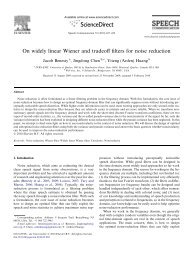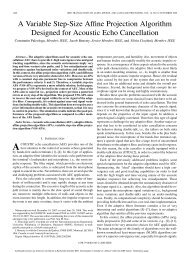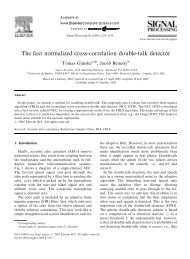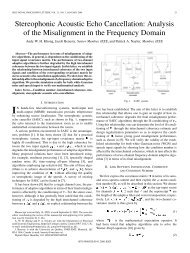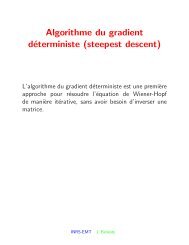A Generalized MVDR Spectrum - ResearchGate
A Generalized MVDR Spectrum - ResearchGate
A Generalized MVDR Spectrum - ResearchGate
Create successful ePaper yourself
Turn your PDF publications into a flip-book with our unique Google optimized e-Paper software.
IEEE SIGNAL PROCESSING LETTERS, VOL. 12, NO. 12, DECEMBER 2005 827<br />
A <strong>Generalized</strong> <strong>MVDR</strong> <strong>Spectrum</strong><br />
Jacob Benesty, Senior Member, IEEE, Jingdong Chen, Member, IEEE, and Yiteng (Arden) Huang, Member, IEEE<br />
Abstract—The minimum variance distortionless response<br />
(<strong>MVDR</strong>) approach is very popular in array processing. It is also<br />
employed in spectral estimation where the Fourier matrix is used<br />
in the optimization process. First, we give a general form of the<br />
<strong>MVDR</strong> where any unitary matrix can be used to estimate the<br />
spectrum. Second and most importantly, we show how the <strong>MVDR</strong><br />
method can be used to estimate the magnitude squared coherence<br />
function, which is very useful in so many applications but so few<br />
methods exist to estimate it. Simulations show that our algorithm<br />
gives much more reliable results than the one based on the popular<br />
Welch’s method.<br />
Index Terms—Capon, coherence function, cross-spectrum, minimum<br />
variance distortionless response (<strong>MVDR</strong>), periodogram,<br />
spectral estimation, spectrum.<br />
I. INTRODUCTION<br />
SPECTRAL estimation is a very important topic in signal<br />
processing, and applications demanding it are countless<br />
[1]–[3]. There are basically two broad categories of techniques<br />
for spectral estimation. One is the nonparametric approach,<br />
which is based on the concept of bandpass filtering. The other<br />
is the parametric method, which assumes a model for the<br />
data, and the spectral estimation then becomes a problem of<br />
estimating the parameters in the assumed model. If the model<br />
fits the data well, the latter may yield a more accurate spectral<br />
estimate than the former. However, in the case that the model<br />
does not satisfy the data, the parametric model will suffer significant<br />
performance degradation and lead to a biased estimate.<br />
Therefore, a great deal of research efforts are still devoted to<br />
the nonparametric approaches.<br />
One of the most well-known nonparametric spectral estimation<br />
algorithms is the Capon’s approach, which is also known<br />
as minimum variance distortionless response (<strong>MVDR</strong>) [4], [5].<br />
This technique was extensively studied in the literature and is<br />
considered as a high-resolution method. The <strong>MVDR</strong> spectrum<br />
can be viewed as the output of a bank of filters, with each filter<br />
centered at one of the analysis frequencies. Its bandpass filters<br />
are both data and frequency dependent, which is the main difference<br />
with a periodogram-based approach where its bandpass<br />
filters are a discrete Fourier matrix, which is both data and frequency<br />
independent [3], [6].<br />
The objective of this letter is twofold. First, we generalize the<br />
concept of the <strong>MVDR</strong> spectrum. Second and most importantly,<br />
Manuscript received June 2, 2005; revised July 14, 2005. The associate editor<br />
coordinating the review of this manuscript and approving it for publication was<br />
Dr. Hakan Johansson.<br />
J. Benesty is with the Université du Québec, INRS-EMT, Montréal, QC,<br />
H5A 1K6, Canada (e-mail: benesty@emt.inrs.ca).<br />
J. Chen and Y. Huang are with Bell Laboratories, Lucent Technologies,<br />
Murray Hill, NJ 07974 USA (e-mail: jingdong@research.bell-labs.com;<br />
arden@research.bell-labs.com).<br />
Digital Object Identifier 10.1109/LSP.2005.859517<br />
we show how to use this approach to estimate the magnitude<br />
squared coherence (MSC) function as an alternative to the popular<br />
Welch’s method [7].<br />
Let<br />
input of<br />
II. GENERAL FORM OF THE SPECTRUM<br />
be a zero-mean stationary random process that is the<br />
filters of length<br />
where superscript denotes transposition.<br />
If we denote by the output signal of the filter , its<br />
power is<br />
where is the mathematical expectation, superscript denotes<br />
transpose conjugate of a vector or a matrix<br />
is the covariance matrix of the input signal<br />
In the rest of this letter, we always assume that<br />
definite.<br />
Consider the unitary matrix<br />
, and<br />
(1)<br />
(2)<br />
is positive<br />
with<br />
. In the proposed generalized <strong>MVDR</strong><br />
method, the filter coefficients are chosen so as to minimize the<br />
variance of the filter output, subject to the constraint<br />
Under this constraint, the process is passed through the<br />
filter with no distortion along and signals along other<br />
vectors than tend to be attenuated. Mathematically, this is<br />
equivalent to minimizing the following cost function:<br />
where is a Lagrange multiplier. The minimization of (4) leads<br />
to the following solution:<br />
We define the spectrum of along as<br />
(3)<br />
(4)<br />
(5)<br />
(6)<br />
1070-9908/$20.00 © 2005 IEEE
828 IEEE SIGNAL PROCESSING LETTERS, VOL. 12, NO. 12, DECEMBER 2005<br />
Therefore, plugging (5) into (6), we find that<br />
(7)<br />
The first obvious choice for the unitary matrix<br />
Fourier matrix<br />
is the<br />
Expression (7) is a general definition of the spectrum of the<br />
signal , which depends on the unitary matrix . Replacing<br />
the previous equation in (5), we get<br />
where<br />
Taking into account all vectors<br />
the general form<br />
where<br />
(8)<br />
, (8) has<br />
(9)<br />
and . Of course, is a<br />
unitary matrix. With this choice, we obtain the classical Capon’s<br />
method.<br />
Now suppose . In this case, a Toeplitz matrix is<br />
asymptotically equivalent to a circulant matrix if its elements<br />
are absolutely summable [8], which is usually the case in most<br />
applications. Hence, we can decompose as<br />
(12)<br />
and<br />
diag<br />
is a diagonal matrix.<br />
Property 1: We have<br />
(10)<br />
Proof: This form follows immediately from (9).<br />
Property 1 shows that there are an infinite number of ways<br />
to decompose matrix , depending on how we choose the<br />
unitary matrix . Each one of these decompositions gives a<br />
representation of the square of the spectrum of the signal<br />
in the subspace .<br />
Property 2: We have<br />
Proof: Indeed<br />
tr<br />
tr tr (11)<br />
tr<br />
Property 2 expresses the energy conservation. So no matter<br />
what we take for the unitary matrix , the sum of all values of<br />
the inverse spectrum is always the same.<br />
A. Particular Cases<br />
In this subsection, we propose to briefly discuss three important<br />
particular cases of the general form of the <strong>MVDR</strong> spectrum.<br />
tr<br />
tr<br />
so that . As a result, for a stationary signal and asymptotically,<br />
Capon’s approach is equivalent to the periodogram. The<br />
difference between the <strong>MVDR</strong> and periodogram approaches can<br />
also be viewed as the difference between the eigenvalue decompositions<br />
of circulant and Toeplitz matrices. While for a circulant<br />
matrix, its corresponding unitary matrix is data independent,<br />
it is not for a Toeplitz matrix.<br />
The second natural choice for is the matrix containing the<br />
eigenvectors of the correlation matrix . Indeed, it is well<br />
known that can be diagonalized as follows [9]:<br />
(13)<br />
where is a unitary matrix containing the eigenvectors , and<br />
is a diagonal matrix containing the corresponding eigenvalues<br />
. Thus, taking ,wefind that and<br />
(14)<br />
In many applications, the process signal is real, and it<br />
may be more convenient to select an orthogonal matrix instead<br />
of a unitary one. So our third and final particular case is the<br />
discrete cosine transform<br />
where the rest is shown in the equation at the bottom of the<br />
page, with and for .We<br />
can verify that<br />
. So with this orthogonal<br />
transform, the spectrum is<br />
diag (15)
BENESTY et al.: GENERALIZED <strong>MVDR</strong> SPECTRUM 829<br />
III. APPLICATION TO THE CROSS-SPECTRUM<br />
AND MSC FUNCTION<br />
In this section, we show how to use the generalized <strong>MVDR</strong><br />
approach for the estimation of the cross-spectrum and the MSC<br />
function.<br />
A. General Form of the Cross-<strong>Spectrum</strong><br />
We assume here that we have two zero-mean stationary<br />
random signals and with respective spectra<br />
and . As explained in Section II, we can<br />
design two filters<br />
For (23) to have the true sense of the cross-spectrum definition,<br />
the matrix should be complex (and unitary).<br />
Property 3: We have<br />
tr<br />
(24)<br />
Proof: This is easy to see from (23).<br />
Property 3 is similar to property 2 and shows another form of<br />
energy conservation.<br />
to find the spectra of and along<br />
where<br />
(16)<br />
(17)<br />
B. General Form of the MSC Function<br />
We define the MSC function between two signals and<br />
as<br />
(25)<br />
From (23), we deduce the magnitude squared cross-spectrum<br />
(26)<br />
is the covariance matrix of the signal<br />
and<br />
(18)<br />
Using expressions (17) and (26) in (25), the MSC becomes<br />
(27)<br />
Property 4: We have<br />
Let and be the respective outputs of the filters<br />
and .Wedefine the cross-spectrum between and<br />
along as<br />
(19)<br />
(28)<br />
Proof: Since matrices and are assumed to<br />
be positive definite, it is clear that<br />
. To prove that<br />
, we need to rewrite the MSC function. Define<br />
the vectors<br />
where the superscript<br />
Similarly<br />
is the complex conjugate operator.<br />
and the normalized cross-correlation matrix<br />
(29)<br />
(30)<br />
(20)<br />
Using the previous definitions in (27), the MSC is now<br />
Now if we develop (19), we get<br />
where<br />
(21)<br />
(22)<br />
is the cross-correlation matrix between and . Replacing<br />
(16) in (21), we obtain the cross-spectrum<br />
(23)<br />
Consider the Hermitian positive semidefinite matrix<br />
and the vectors<br />
(31)<br />
(32)<br />
(33)<br />
(34)
830 IEEE SIGNAL PROCESSING LETTERS, VOL. 12, NO. 12, DECEMBER 2005<br />
We can easily check that<br />
(35)<br />
(36)<br />
Inserting these expressions in the Cauchy–Schwartz inequality<br />
(37)<br />
we see that .<br />
Property 4 was, of course, expected in order that the definition<br />
(27) of the MSC could have a sense.<br />
C. Simulation Example<br />
In this subsection, we compare the MSC function estimated<br />
with our approach and with the MATLAB function “cohere”<br />
that uses the Welch’s averaged periodogram method [7]. We<br />
consider the illustrative example of two signals and<br />
that do not have that much in common, except for two sinusoids<br />
at frequencies and<br />
(38)<br />
(39)<br />
where and are two independent zero-mean (real)<br />
white Gaussian random processes with unit variance. The<br />
phases and in the signal are random. In this<br />
example, the theoretical coherence should be equal to at<br />
the two frequencies and and at the others. Here we<br />
chose and . For both algorithms, we<br />
took 1024 samples and a window of length . As for<br />
the choice of the unitary matrix in our approach, we took the<br />
Fourier matrix. Fig. 1(a) and (b) give the MSC estimated with<br />
MATLAB and our method, respectively. Clearly, the estimation<br />
of the coherence function with our algorithm is much closer to<br />
its theoretical values.<br />
IV. CONCLUSION<br />
The <strong>MVDR</strong> principle is very popular in array processing<br />
and spectral estimation. In this letter, we have shown that this<br />
concept can be generalized to unitary matrices other than the<br />
Fig. 1.<br />
Estimation of the MSC function. (a) MATLAB function “cohere.” (b)<br />
Proposed algorithm with U = F. Conditions of simulations: K =100and a<br />
number of samples of 1024.<br />
Fourier transform for spectrum evaluation. Most importantly,<br />
we have given an alternative to the popular Welch’s method for<br />
the estimation of the MSC function. Simulations show that the<br />
new method works much better.<br />
REFERENCES<br />
[1] S. L. Marple, Jr., Digital Spectral Analysis with Applications. Englewood<br />
Cliffs, NJ: Prentice-Hall, 1987.<br />
[2] S. M. Kay, Modern Spectral Estimation: Theory and Application. Englewood<br />
Cliffs, NJ: Prentice-Hall, 1988.<br />
[3] P. Stoica and R. L. Moses, Introduction to Spectral Analysis. Upper<br />
Saddle River, NJ: Prentice-Hall, 1997.<br />
[4] J. Capon, “High resolution frequency-wavenumber spectrum analysis,”<br />
Proc. IEEE, vol. 57, no. 8, pp. 1408–1418, Aug. 1969.<br />
[5] R. T. Lacoss, “Data adaptive spectral analysis methods,” Geophys., vol.<br />
36, pp. 661–675, Aug. 1971.<br />
[6] P. Stoica, A. Jakobsson, and J. Li, “Matched-filter bank interpretation<br />
of some spectral estimators,” Signal Process., vol. 66, pp. 45–59, Apr.<br />
1998.<br />
[7] P. D. Welch, “The use of fast Fourier transform for the estimation of<br />
power spectra: A method based on time averaging over short, modified<br />
periodograms,” IEEE Trans. Audio Electroacoust., vol. AU-15, no. 2,<br />
pp. 70–73, Jun. 1967.<br />
[8] R. M. Gray, “Toeplitz and Circulant Matrices: A Review,” Stanford<br />
Univ., Stanford, CA, Int. Rep., 2002.<br />
[9] S. Haykin, Adaptive Filter Theory, 4th ed. Englewood Cliffs, NJ: Prentice-Hall,<br />
2002.



